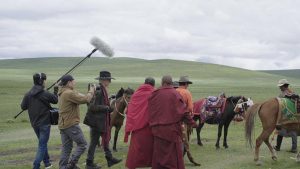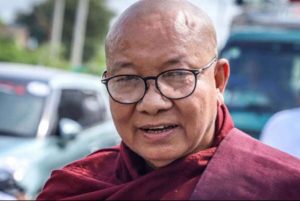
Pure Land patriarchal founders are enlightened masters backed up by the Buddha
In my previous article, “The Pure Land Lineage from Shakyamuni Buddha to Master Shandao,” we noted that Pure Land patriarchs, such as Nagarjuna Bodhisattva in India or Master Shandao in China, are eminent and enlightened masters who are accepted as having a correct understanding of the sutras spoken by Shakyamuni Buddha.
Nagarjuna Bodhisattva (c. 150–250 CE), whose appearance in India was predicted by Shakyamuni Buddha in the Sutra of Entry into Lankavatara, identified the lifeline of Pure Land doctrine: Amitabha’s Fundamental Vow of Deliverance, the 18th Vow. He classified the Buddhist teachings of Shakyamuni Buddha into the paths of “Easy Practice” and “Difficult Practice,” the former being the Pure Land teaching, while the latter being all other Buddhist teachings.
All other Pure Land patriarchs followed this definitive lifeline of the Pure Land teaching; they further classified the Buddhist Dharma, and wrote commentaries on the Pure Land sutras, thus pointing out the unique principles and characteristics of the Pure Land way. Master Shandao (613–81 CE) of the Tang dynasty, regarded as an incarnation of Amitabha Buddha, synthesized the Pure Land teachings into a coherent, systematic, and complete framework. It was the foundation on which he inaugurated the Pure Land school in China.
Propagating the Buddhist teachings through the lineage of a school
Why is it necessary for patriarchs to inaugurate different schools of Buddhism in propagating and transmitting the teachings of Shakyamuni Buddha? The short answer is that it is difficult to believe in and accept, interpret, and practice the unsurpassed Buddhist teachings!
It is difficult, mainly because we lack the direct support, guidance, and supervision of the Buddha, who entered Nirvana more than 2,000 years ago. Moreover, it is difficult because the aptitude of ordinary beings is inferior, with poor virtuous roots, so that they cannot believe in and accept, interpret, and practice the profound teachings of the Buddha.
Thus, patriarchs, such as Nagarjuna Bodhisattva in India, analysed, systematised, and classified the abundant Buddhist teachings, and grouped them into several major paths or schools in accordance with the sutras spoken by the Buddhas. This is so that practitioners of different aptitudes can follow, study, and practice to attain enlightenment within their chosen school, according to their capacities.
The importance of following lineage in practicing the Buddhist teaching
Why is it important for us to follow the lineage of a particular school of Buddhism in practicing the Buddhist teaching? It is because the teaching formulated by a particular school (inaugurated by the patriarch) represents the proper, correct, and direct teaching of Shakyamuni Buddha.
Why is it important for us to follow the proper Dharma teaching of Shakyamuni Buddha? It is because we are assured of attaining enlightenment and thus ultimate emancipation by following, studying, and practicing the proper Dharma, with the direct support of Shakyamuni Buddha.
In the context of the Pure Land teaching, we are assured of attaining rebirth in Amitabha’s Land of Bliss by following the Pure Land teaching in the tradition of Master Shandao. It is identical to following, studying, and practicing the proper Dharma teaching of Shakyamuni Buddha spoken in the three Pure Land sutras. That is the reason why it is important for us to follow the lineage of the Pure Land school in practicing the Pure Land teaching.
Pure Land is a teaching of practice, rather than a teaching of understanding
For all Pure Land practitioners, it is particularly important to keep this concept of lineage in mind because Pure Land is a teaching of practice, rather than a teaching of understanding. As stated by Master Shandao: “If a person wishes to study the Buddhist teaching through the understanding of theoretical interpretations, then he should proceed step by step—from the status of an ordinary being, to a sacred being, to the fullness of Buddhahood. One should not cease his studies until he has become free of all obstructions.
“However, if a person wishes to study the Buddhist teaching through practice [such as the Pure Land teaching], he should act with recourse to the teaching that favors one’s aptitude and conditions. Thus, it is better to assert less self-power, so as to attain more benefits.”
In other words, the Pure Land is a teaching of practice that relies on “external power” or “other-power” (Amitabha Buddha’s vow power) as an augmentative causal condition for deliverance, which is rebirth into Amitabha’s Land of Bliss.
Moreover, the pristine Pure Land teaching involves full and complete reliance on “other-power” for deliverance to the Pure Land with recourse to Amitabha’s vow power. Thus, it must be practiced in strict accordance with the proper Dharma teaching expounded by Shakyamuni Buddha in the three Pure Land sutras. This is to be in strict accordance with the lineage of the Pure Land school.
Two teachings, the Common Path and the Particular Path, cannot be mixed together
Another remarkable Pure Land patriarch, Master Yinguang, says: “For practices in cultivation, there are two kinds. One can practice precepts, meditation, and wisdom through self-power, aspiring to cut off all delusions and to realize the ultimate truth and liberate oneself from the endless cycle of birth and death. This teaching is called the ‘Common Path.’ Alternatively, one can have genuine faith and earnest aspiration, and hold fast to Amitabha’s name, anticipating rebirth with recourse to the Buddha’s compassionate [vow] power. This teaching is called the ‘Particular Path.’
The Particular Path refers to the pristine Pure Land teaching based on Amitabha’s Fundamental Vow of deliverance, the 18th Vow. Master Yinguang further says: “In studying the Dharma, these two teachings cannot be mixed together. If we study either one, we will gain; however, if we study them together at the same time, we will lose.”
The last statement reveals the reason why many Buddhists who switch from the Common Path to the Particular Path, cannot attain assured rebirth in Amitabha’s splendid reward land in their present life. While they accept the Pure Land teaching, they still combine it with elements from the Common Path and hope to attain rebirth through an admixture of their own merits with those of Amitabha.











